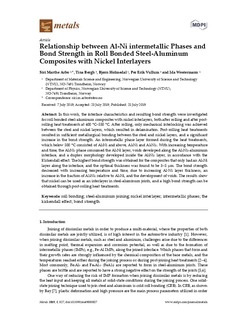| dc.contributor.author | Arbo, Siri Marthe | |
| dc.contributor.author | Bergh, Tina | |
| dc.contributor.author | Holmedal, Bjørn | |
| dc.contributor.author | Vullum, Per Erik | |
| dc.contributor.author | Westermann, Ida | |
| dc.date.accessioned | 2019-08-09T11:02:50Z | |
| dc.date.available | 2019-08-09T11:02:50Z | |
| dc.date.created | 2019-07-26T09:00:35Z | |
| dc.date.issued | 2019 | |
| dc.identifier.issn | 2075-4701 | |
| dc.identifier.uri | http://hdl.handle.net/11250/2607760 | |
| dc.description.abstract | In this work, the interface characteristics and resulting bond strength were investigated for roll bonded steel-aluminum composites with nickel interlayers, both after rolling and after post-rolling heat treatments at 400 °C–550 °C. After rolling, only mechanical interlocking was achieved between the steel and nickel layers, which resulted in delamination. Post-rolling heat treatments resulted in sufficient metallurgical bonding between the steel and nickel layers, and a significant increase in the bond strength. An intermetallic phase layer formed during the heat treatments, which below 500 °C consisted of Al3Ni and above, Al3Ni and Al3Ni2. With increasing temperature and time, the Al3Ni2 phase consumed the Al3Ni layer, voids developed along the Al3Ni2-aluminum interface, and a duplex morphology developed inside the Al3Ni2 layer, in accordance with the Kirkendall effect. The highest bond strength was obtained for the composites that only had an Al3Ni layer along the interface, and the optimal thickness was found to be 3–5 µm. The bond strength decreased with increasing temperature and time, due to increasing Al-Ni layer thickness, an increase in the fraction of Al3Ni2 relative to Al3Ni, and the development of voids. The results show that nickel can be used as an interlayer in steel-aluminum joints, and a high bond strength can be obtained through post-rolling heat treatments. | nb_NO |
| dc.language.iso | eng | nb_NO |
| dc.publisher | MDPI | nb_NO |
| dc.rights | Navngivelse 4.0 Internasjonal | * |
| dc.rights.uri | http://creativecommons.org/licenses/by/4.0/deed.no | * |
| dc.title | Relationship between Al-Ni intermetallic Phases and Bond Strength in Roll Bonded Steel-Aluminum Composites with Nickel Interlayers | nb_NO |
| dc.type | Journal article | nb_NO |
| dc.type | Peer reviewed | nb_NO |
| dc.description.version | publishedVersion | nb_NO |
| dc.source.volume | 9 | nb_NO |
| dc.source.journal | Metals | nb_NO |
| dc.source.issue | 8 | nb_NO |
| dc.identifier.doi | https://doi.org/10.3390/met9080827 | |
| dc.identifier.cristin | 1712794 | |
| dc.relation.project | Norges forskningsråd: 237900 | nb_NO |
| dc.relation.project | Norges forskningsråd: 197405 | nb_NO |
| dc.relation.project | Norges forskningsråd: 245963/F50 | nb_NO |
| dc.description.localcode | © 2019 by the authors. Licensee MDPI, Basel, Switzerland. This article is an open access article distributed under the terms and conditions of the Creative Commons Attribution (CC BY) license (http://creativecommons.org/licenses/by/4.0/). | nb_NO |
| cristin.unitcode | 194,66,35,0 | |
| cristin.unitcode | 194,66,20,0 | |
| cristin.unitname | Institutt for materialteknologi | |
| cristin.unitname | Institutt for fysikk | |
| cristin.ispublished | true | |
| cristin.fulltext | original | |
| cristin.qualitycode | 1 | |

